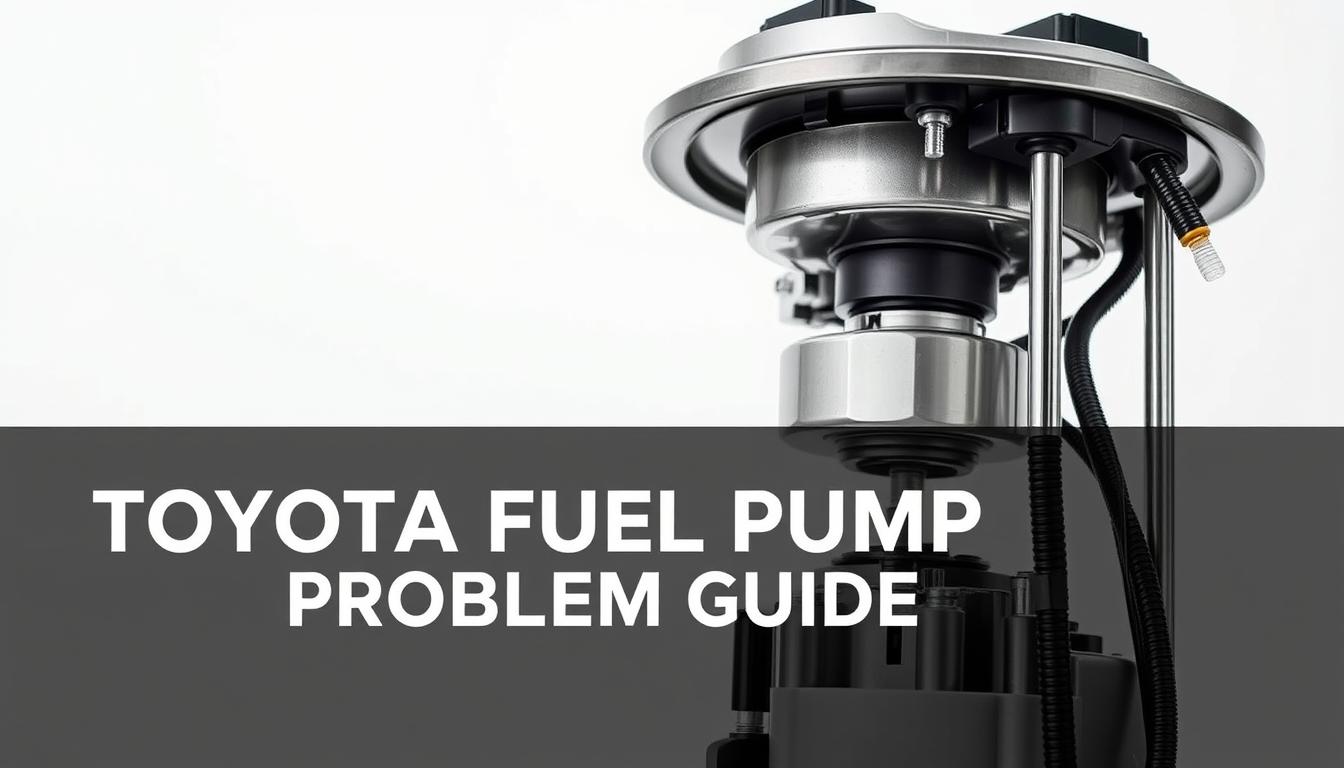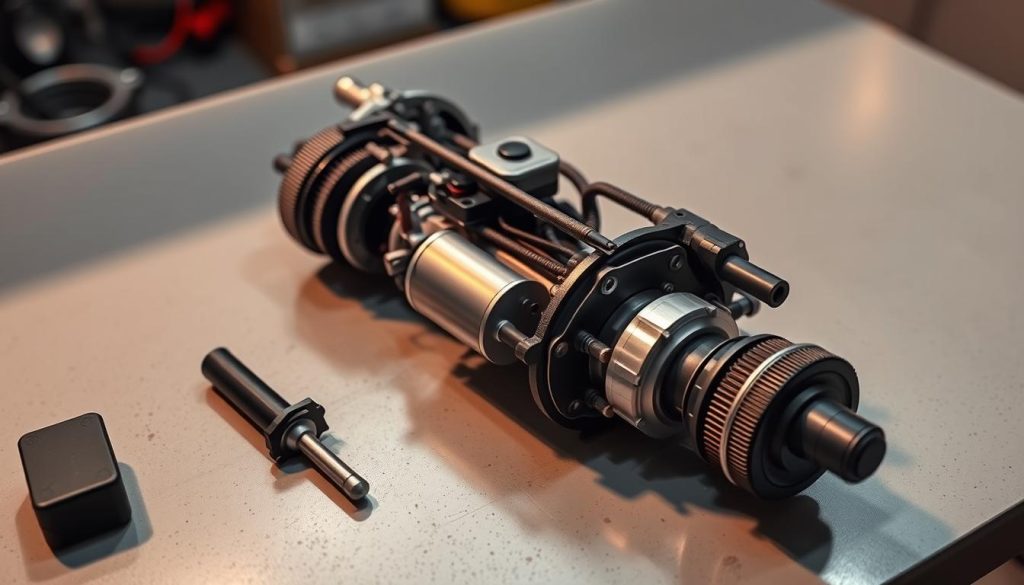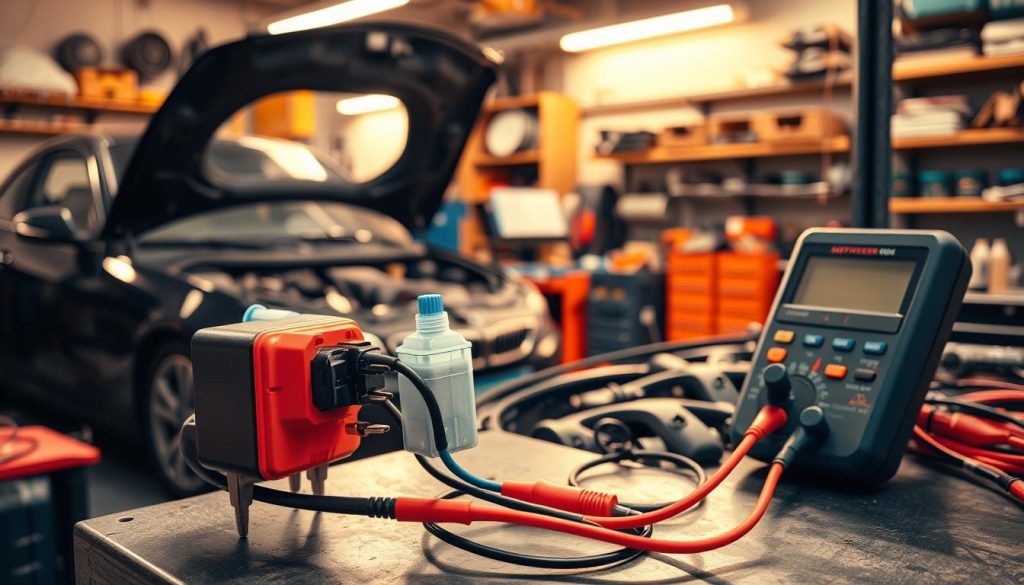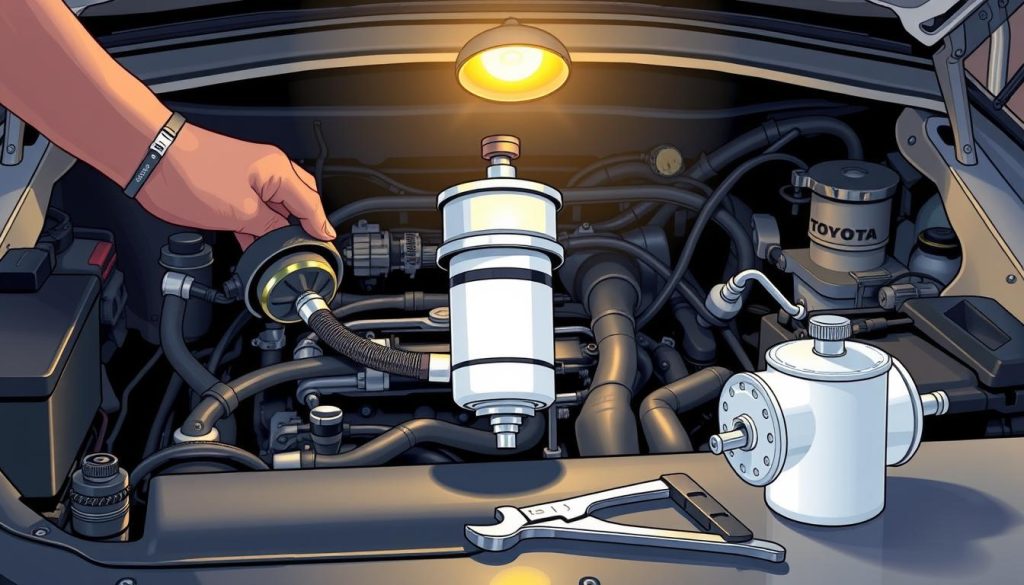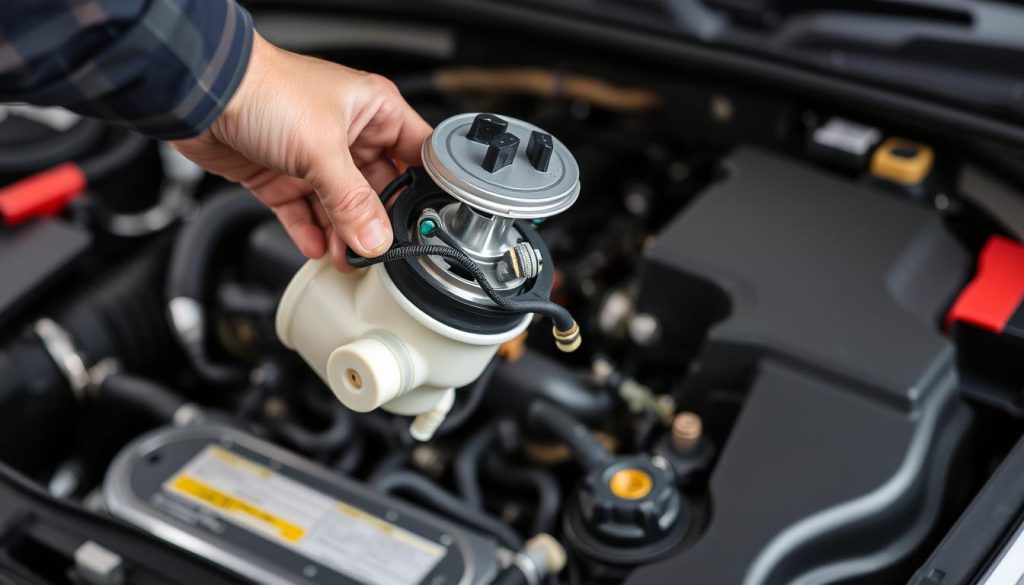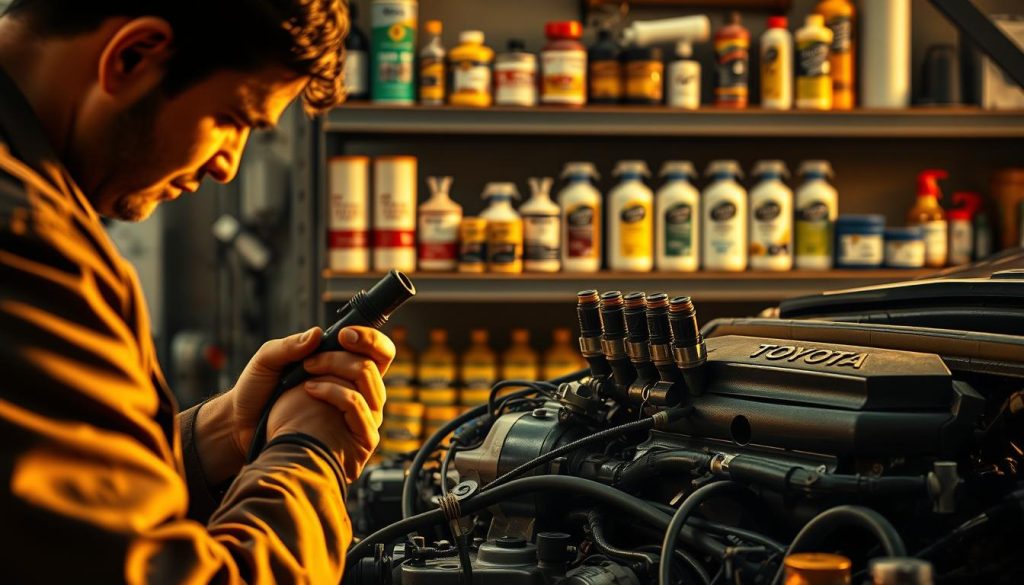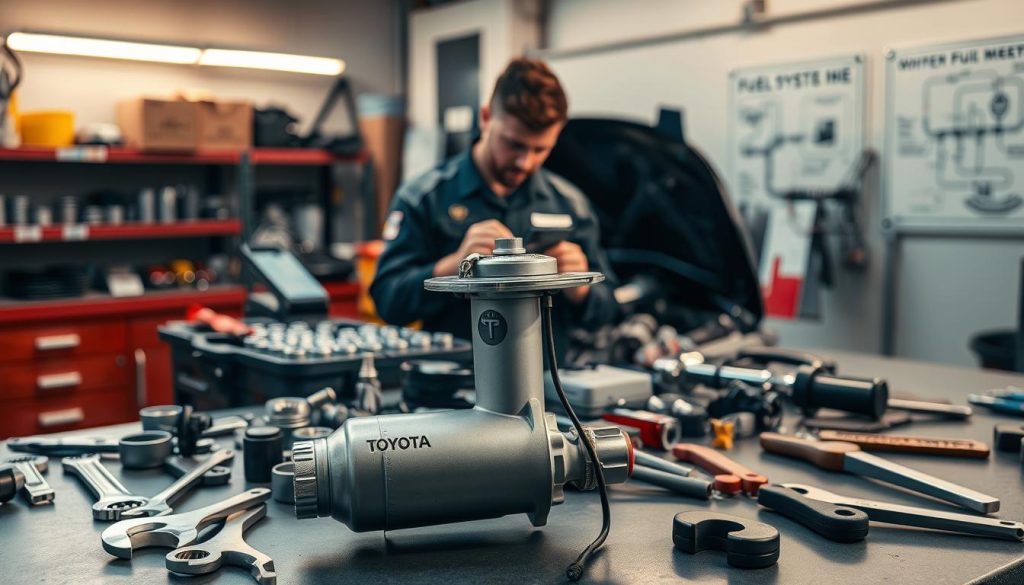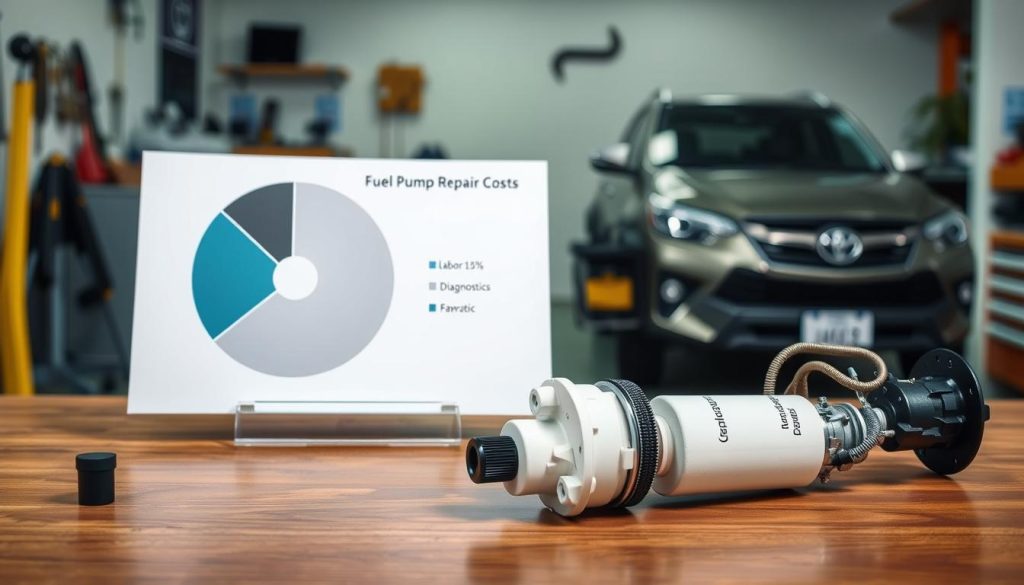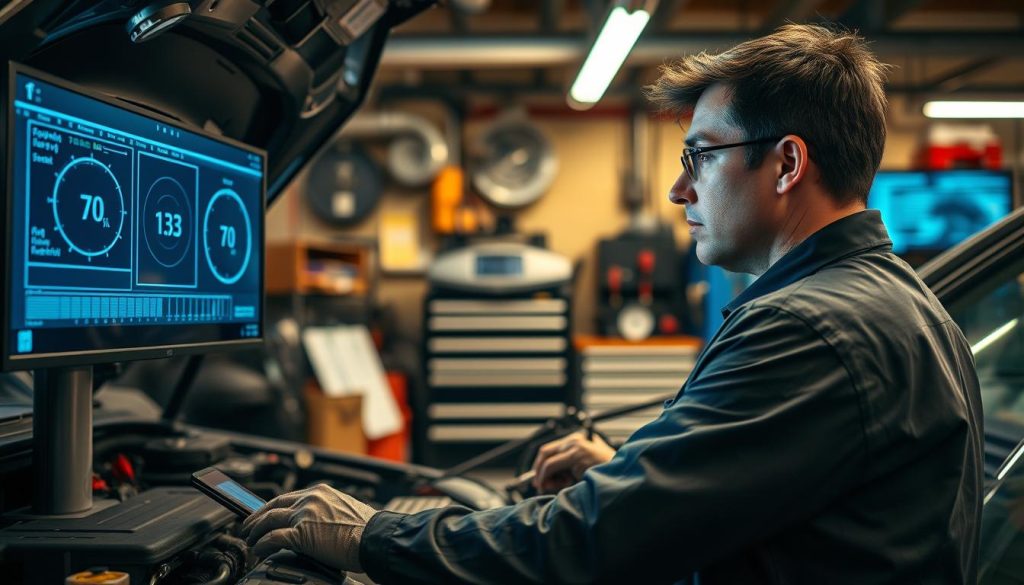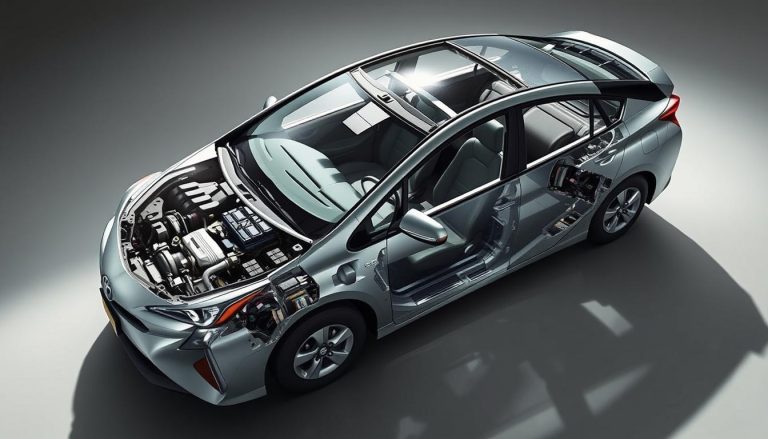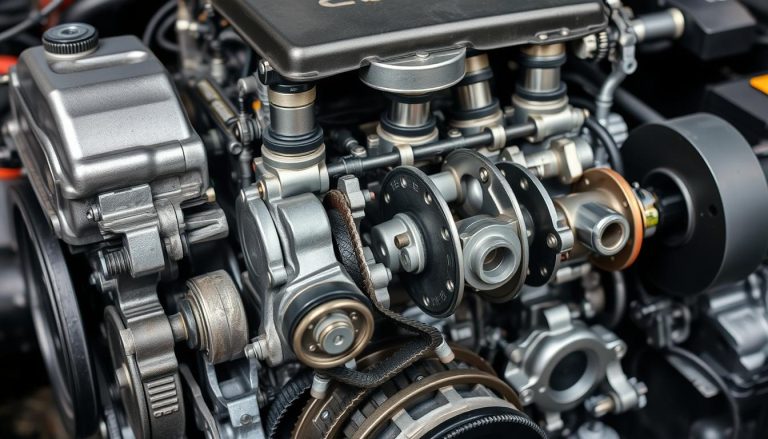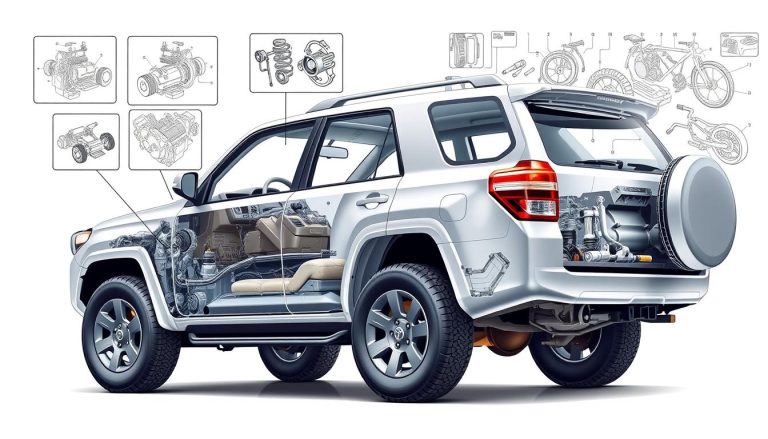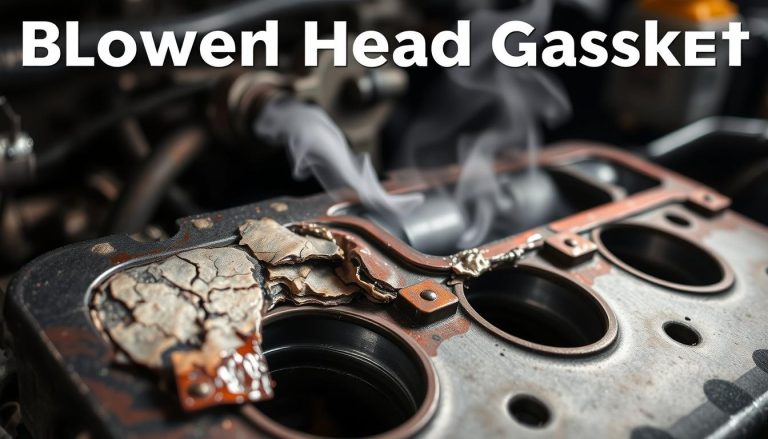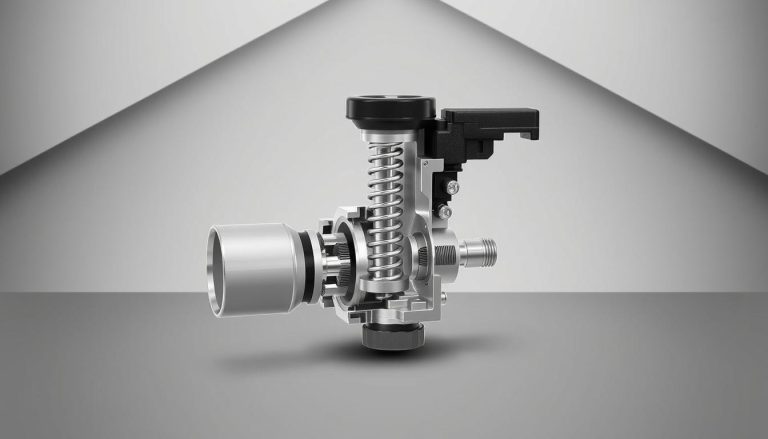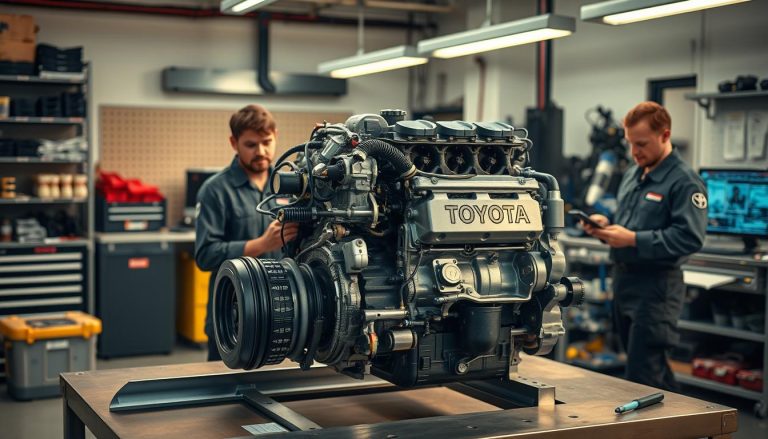Toyota Fuel Pump Problems: Symptoms and Solutions Guide
Your vehicle’s fuel delivery system is key to getting your car running. It moves gasoline from the tank to the engine. If it fails, you might find yourself stuck.
Signs of fuel system issues include the car stalling or being hard to start. You might also hear strange noises from the tank. These signs often mean the fuel pump is failing, affecting many drivers each year. Not fixing these problems early can lead to a dead engine and expensive fixes.
This guide will help you spot and fix engine performance problems before they get worse. You’ll learn how to diagnose issues, find solutions, and keep your fuel system in top shape. Whether you’re dealing with small problems or big ones, this guide has the info you need for safe, effective fixes.
Key Takeaways
- Early detection of fuel system issues prevents costly engine damage and breakdowns
- Common symptoms include engine stalling, hard starting, and unusual tank noises
- Proper diagnosis requires understanding both mechanical and electrical components
- Regular maintenance extends fuel delivery system lifespan significantly
- Professional inspection is recommended for complex fuel system repairs
- Preventive measures can reduce the likelihood of sudden pump failure
Understanding Toyota Fuel System Components
Modern Toyota vehicles use advanced fuel system technology. This technology has changed a lot over the years. The Toyota fuel system is made up of many parts designed to work together well.
This fuel delivery system makes sure your engine gets the right amount of fuel. It does this at the right pressure, no matter how you’re driving.
How Toyota Fuel Pumps Work
Toyota fuel pumps create pressure to move gasoline from the tank to the engine. The electric fuel pump uses an electric motor. This motor spins an impeller inside a housing.
This spinning action pulls fuel into the pump and pushes it out under pressure. The pump keeps the pressure steady in the fuel rails.
Keeping fuel pressure steady is key for good engine performance and fuel efficiency.
Types of Fuel Pumps in Toyota Vehicles
Toyota has used two main types of fuel pumps over time. Mechanical fuel pump systems were used in older Toyotas before the 1990s. These pumps used engine vacuum to draw fuel from the tank.
Now, all Toyotas use electric fuel pump systems. These pumps are more reliable and control fuel flow better than mechanical pumps.
Common Fuel System Components
The Toyota fuel system includes many important parts. The fuel tank holds gasoline, and fuel lines carry it around. Fuel filters clean the fuel before it reaches the engine.
Other key parts are fuel injectors, pressure regulators, and fuel rails. Each part is essential for the engine to run well and for good fuel economy.
Recognizing Toyota Fuel Pump Problems Early
Spotting fuel pump issues early can save you from big repair bills and dangerous breakdowns. Early recognition of fuel pump symptoms lets you fix problems before they get worse. Knowing the signs helps you avoid major engine damage.
Your Toyota’s performance can tell you a lot about its fuel system. Watching for early signs can help you avoid expensive repairs later.
Engine Performance Symptoms
Engine problems often signal fuel pump failure. Engine stalling is a common symptom Toyota owners see. It happens when the fuel pump can’t keep up with the engine’s needs.
Starting issues can also point to a failing fuel pump. You might find your engine takes longer to start, more so in cold weather. Hesitation during acceleration and sputtering at high speeds are other signs of fuel delivery problems.
Power loss when going up hills or merging onto highways is another symptom. These signs get worse as the fuel pump gets weaker.
Unusual Sounds and Noises
Your ears can pick up on fuel pump issues before they get serious. Fuel pump noise sounds like a loud whine or buzz from the fuel tank area. This noise gets louder when your tank is about a quarter full or less.
A good fuel pump is quiet. But if you hear constant whining, it’s struggling to keep fuel flowing. The noise gets louder when you accelerate or go up hills.
Fuel System Warning Signs
There are subtle signs of fuel system problems. If your car uses more fuel than usual, it might be a sign. You might need to fill up more often, even if you’re not driving much.
Engine misfires and rough idling mean fuel isn’t being delivered right. Check engine lights might come on if fuel pressure drops too low. These signs come on slowly, giving you time to get it fixed before it fails completely.
Keep an eye on how your Toyota acts in different situations. Fixing problems early can save you money and keep you safe.
Step-by-Step Fuel Pump Diagnostic Process
Identifying fuel pump issues early saves money and time. Modern Toyotas have advanced systems for accurate diagnosis. This process ensures you fix the real problem efficiently.
Experts follow a four-step method. Each step builds on the last, giving a full picture of your fuel system’s health.
Initial Visual Inspection
Begin by visually checking all parts you can see. Look for damage around the fuel tank, lines, and connections. Fuel stains, corrosion, or loose fittings often show the problem right away.
Check the fuel cap and tank for cracks or damage. Also, inspect fuel lines for kinks, wear, or loose clamps. This simple step can save a lot of time.
Testing Fuel Pressure
Fuel pressure testing is key to understanding pump performance. Use a pressure gauge on your Toyota’s fuel rail test port. Proper pressure readings show if your pump meets specs for your model year.
Run the test with the engine on and off. Compare your results to Toyota’s recommended pressure ranges. Low readings often mean pump failure.
Electrical System Checks
Many fuel pump failures are due to electrical issues, not mechanical ones. First, test the fuel pump relay. A faulty relay can seem like a complete failure but costs just a few dollars to fix.
Next, check all wiring connections for damage or corrosion. Electrical testing should also include voltage measurements at the pump connector to ensure power supply.
Computer Diagnostic Scanning
Modern Toyotas store diagnostic trouble codes that reveal fuel system problems. Use an OBD-II scanner to check for codes like P0171 or P0174, which often indicate fuel delivery issues. These codes give clues about the problem’s nature and location.
| Diagnostic Step | Time Required | Equipment Needed | Skill Level |
|---|---|---|---|
| Visual Inspection | 10-15 minutes | Flashlight, basic tools | Beginner |
| Pressure Testing | 20-30 minutes | Fuel pressure gauge | Intermediate |
| Electrical Checks | 15-25 minutes | Multimeter, test light | Intermediate |
| Code Scanning | 5-10 minutes | OBD-II scanner | Beginner |
A systematic approach to diagnosis prevents unnecessary part replacement and ensures you fix the actual problem the first time.
Toyota Models Most Affected by Fuel Pump Issues
Many Toyota models face fuel pump problems that affect thousands of drivers. Even though Toyota is known for reliability, some cars are more prone to fuel system issues. Knowing these patterns helps owners avoid unexpected breakdowns.
Some Toyota models have more fuel pump failures. These problems often start between 100,000 and 150,000 miles. But, some cases happen sooner.
2007-2011 Camry Problems
The Toyota Camry fuel pump in these years has a high failure rate. It often affects the fuel pump module assembly. Owners notice starting issues and sudden drops in engine performance.
These Camry models usually face fuel pump problems around 120,000 miles. Replacing the whole fuel pump assembly is often needed, not just fixing parts.
2009-2013 Corolla Issues
Toyota Corolla fuel pump problems show up as engine hesitation and starting issues in hot weather. Many owners face stalling, mostly in stop-and-go traffic.
The fuel pump assemblies in these Corollas often fail the internal pressure regulator. Hot climates make these problems worse, with Arizona and Texas seeing more cases.
RAV4 and Highlander Common Failures
Both Toyota RAV4 and Toyota Highlander fuel pump systems have similar failure patterns in high-mileage vehicles. They often have reduced acceleration and engine misfires under heavy loads.
Poor fuel quality speeds up pump wear in these models. Keeping the fuel system well-maintained can extend pump life and avoid expensive repairs.
Essential Tools for Fuel Pump Diagnosis
Having the right tools is key to figuring out what’s wrong with your Toyota. The right gear helps you find problems fast and work safely around fuel systems.
Basic Hand Tools Required
Begin with basic wrenches and socket sets to open fuel system covers. You’ll need both metric and standard sizes for different Toyotas. Phillips and flathead screwdrivers are also needed for electrical connections.
A good multimeter is essential for electrical checks. It tests voltage, continuity, and resistance in fuel pump circuits. Digital multimeters are more accurate than analog ones.
Specialized Diagnostic Equipment
Professional fuel pressure gauges are needed for accurate pressure checks. Look for kits with multiple adapters for different Toyota fuel rails. These gauges show exact pressure during testing.
An OBD-II scanner reads trouble codes from your Toyota’s computer. Advanced scanners show live data, giving real-time fuel system performance. This diagnostic equipment saves a lot of time.
Safety Equipment and Precautions
Keep fire extinguishers rated for gasoline fires nearby when working. Wear safety glasses and fuel-resistant nitrile gloves for protection. Proper safety precautions prevent accidents and injuries.
Work in well-ventilated areas to avoid vapor buildup. Never smoke or use open flames near fuel components. Always disconnect the battery before starting electrical work to prevent sparks.
How to Test Fuel Pump Pressure
A fuel pressure test gives you real data on your Toyota’s fuel pump. It’s a clear way to check if everything is working right. You’ll know exactly how your fuel system is doing.
Experts use pressure testing because it shows real numbers. It tells you if your fuel pump is up to par. This info helps you decide what repairs are needed.
Finding the Test Port Location
Your Toyota’s fuel rail test port looks like a tire valve stem. It’s usually near the intake manifold. Look for a small plastic cap on the Schrader valve.
But, different Toyotas have their ports in different spots. Check your owner’s manual for where it is. Some engines hide it under covers or air intake parts.
Setting Up Your Testing Equipment
First, release the fuel system pressure. Pull the fuel pump fuse and let the engine die. This stops fuel spray when you attach the pressure gauge.
Then, connect the gauge with the right adapter. Put the fuel pump fuse back in. Turn the ignition to “on” without starting the engine to turn on the pump.
Reading Your Test Results
Compare your readings to Toyota’s fuel pump pressure specifications for your model. Most Toyotas need 38-44 PSI. But, your engine might need something different.
Low pressure means your fuel pump might be weak or failing. Slow pressure increase shows wear inside the pump. Fast pressure drops after shutdown often mean leaks.
Keep your test results for later. These numbers help you see how your fuel system changes over time. Regular checks can prevent sudden problems.
Checking Fuel Pump Electrical System
Testing the electrical parts of your Toyota’s fuel pump can prevent unnecessary replacements. Many fuel issues come from electrical problems, not the pump itself. Proper electrical testing helps find the real issue and saves money.
The electrical system has several important parts. These parts control when and how the fuel pump works. Knowing each part helps diagnose problems more easily.
Testing the Fuel Pump Relay
The fuel pump relay sends power to the pump motor. You’ll find it in the engine compartment fuse box. Most Toyotas use a standard relay that’s simple to test.
Begin by swapping the fuel pump relay with another similar one. Try the horn or air conditioning relay if they match in amperage. If the pump works, the original relay is faulty.
You can also test the relay with a multimeter. Look for proper continuity and switching. This gives detailed info on the relay’s performance.
Voltage and Continuity Testing
Voltage testing checks if the fuel pump gets the right power. Use a multimeter to see if there’s 12 volts at the pump connector when the ignition is on. Low voltage means a power supply issue.
Continuity testing checks the whole electrical path. Measure resistance between the pump’s connections. High resistance or open circuits show wiring problems that need fixing before replacing the pump.
Inspecting Wiring and Connections
A detailed wiring inspection uncovers hidden issues that look like pump failure. Look at connections under the vehicle and near the fuel tank. These spots are exposed to moisture and salt.
Clean corroded connections with electrical contact cleaner. Make sure all connections are tight and secure. Loose or damaged wiring can cause intermittent pump operation, which is hard to diagnose.
Fuel Filter Replacement Step-by-Step
Your Toyota’s fuel filter protects against harmful contaminants. A dirty filter can harm your fuel system and make your fuel pump work too hard. This can lead to pump failure and expensive repairs.
Fuel filter replacement is cheaper than fixing the pump. Many problems blamed on the pump are actually caused by a clogged filter. Regular fuel system maintenance can prevent these issues.
Finding Your Filter Location
The Toyota fuel filter location changes with each model and year. Older Toyotas usually have filters on the fuel line, mounted on the frame rail between the tank and engine.
Newer Toyotas might have the filter inside the fuel pump assembly. Check your owner’s manual or service guide for the exact spot. Filters can be found:
- Under the vehicle near the fuel tank
- Along the driver’s side frame rail
- Inside the engine compartment near the firewall
- Integrated within the in-tank fuel pump module
Removing and Installing the Filter
Begin by relieving fuel system pressure. Remove the fuel pump fuse and run the engine until it stalls. Then, disconnect the negative battery cable for safety.
Use the right tools to disconnect fuel lines without damage. Remember the fuel flow direction on the old filter. Install the new one in the same direction with fresh O-rings and seals.
Make sure all connections are secure to avoid fuel leaks. Check that clamps and fittings are tight but not too tight.
Post-Installation Testing
After the replacement, reconnect the battery and replace the fuel pump fuse. Turn the ignition on without starting to pressurize the system. Check all connections for leaks before starting the engine.
Start the engine and let it idle while checking fuel pressure and performance. A good filter replacement should improve your Toyota’s fuel delivery and performance.
Complete Fuel Pump Replacement Guide
Replacing your Toyota’s fuel pump is the best way to fix fuel delivery issues. It’s a detailed process that needs careful planning and safety steps. Following these steps ensures your car works well for a long time.
Preparation and Safety Procedures
Getting ready is key for a successful fuel pump installation. Start by emptying the fuel tank to make it lighter and safer. This makes handling easier.
Next, disconnect the negative battery cable and let the engine cool down. Work in a place with good air flow, away from heat or flames. Always have a fire extinguisher nearby for safety.
Before you start, make sure you have all the tools you need. You’ll need tools for fuel tank access, like a transmission jack and fuel line tools. Having everything ready keeps you safe and on track.
Removing the Failed Fuel Pump
Most Toyotas need you to drop the fuel tank or access the pump through the rear seat. Check your model’s specific needs before you begin.
If you need to drop the tank, start by disconnecting fuel lines and electrical connections. Use a transmission jack to support the tank while removing straps. This keeps the tank stable and safe.
Once you can get to it, disconnect the fuel pump assembly electrical connector and fuel lines. Use the right tool to remove the retaining ring, then lift out the old pump.
Installing the New Fuel Pump
Installing the new pump is the reverse of removing the old one. Make sure the new fuel pump assembly fits right in the tank with all seals in place.
Put in new O-rings and gaskets from the replacement kit. These seals stop leaks and keep the system working right. Tighten the retaining ring as the manufacturer says.
Reconnect all electrical and fuel lines securely. Check each connection to avoid future problems or safety risks.
System Testing and Verification
After installing the new fuel pump, turn on the power and check for leaks. Turn the ignition to “on” without starting to pressurize the system.
Start the engine and watch the fuel pressure. It should be right and the system should run smoothly. Listen for any unusual sounds that might mean something went wrong.
Take a short drive to make sure everything works as it should. This final check confirms the fuel pump replacement was a success and your Toyota is running well.
Fuel System Cleaning and Maintenance
A clean fuel system is key for your Toyota to run well. Regular care stops expensive fixes and keeps your engine in top shape for years. Fuel system cleaning gets rid of harmful buildup that can harm your fuel pump and lower engine performance.
Toyota owners should get their fuel system cleaned every 15,000 miles. This stops carbon buildup and makes parts last longer.
Professional Injector Cleaning Methods
Fuel injector cleaning needs special tools and solutions. Pros use ultrasonic cleaners to remove tough deposits. These machines shake off carbon and varnish buildup with high-frequency vibrations.
You can also use quality injector cleaners from auto parts stores. Add these to your fuel tank every 3,000 miles to keep things running smoothly.
Tank Cleaning Procedures
Fuel tank maintenance is needed when bad fuel gets in your system. Mechanics empty the tank and take out all dirt and sediment. They then clean the inside with approved cleaners to get rid of harmful stuff.
Severe contamination might mean you need a new tank. Water damage or rust can’t always be fixed with regular cleaning.
Creating Your Maintenance Schedule
Make a regular fuel system service plan based on how you drive. City drivers and those in dusty areas need more cleaning than highway drivers.
Keep track of all maintenance done. This helps spot patterns and avoid sudden problems. Regular care saves money and keeps you from being stuck on the side of the road.
Preventing Future Toyota Fuel Pump Problems
Your Toyota’s fuel pump longevity depends on three key factors. These are quality fuel, consistent maintenance, and mindful driving. Taking a proactive approach saves money and prevents breakdowns. Making smart choices today protects your investment tomorrow.
Choosing Quality Fuel
Choosing quality fuel is the first step in preventing fuel pump problems. Premium fuels have better additives that keep your system clean. These additives prevent harmful deposits from building up inside pump components.
Buy fuel from reputable stations with high customer turnover. Fresh fuel has fewer contaminants that can damage your Toyota’s fuel system. Avoid filling up when delivery trucks are present, as this stirs up sediment in underground tanks.
Top Tier fuel brands meet enhanced detergent standards for modern engines. These quality fuels provide superior cleaning properties compared to standard gasoline.
Regular Maintenance Best Practices
Following proper maintenance practices extends fuel pump life. Replace your fuel filter every 30,000 to 40,000 miles as Toyota recommends. Clean filters prevent debris from reaching sensitive pump components.
Schedule regular fuel system inspections with qualified technicians. Early detection of issues prevents minor problems from becoming major repairs. Address warning signs immediately before they escalate.
Driving Habits That Extend Pump Life
Smart driving habits directly impact fuel pump longevity. Never let your fuel tank drop below one-quarter full. Low fuel levels force the pump to work harder and reduce cooling efficiency.
Avoid aggressive acceleration when fuel levels are low. This puts additional stress on pump components and can lead to premature failure. Maintain steady speeds and gentle acceleration patterns.
| Prevention Method | Frequency | Expected Benefit | Cost Impact |
|---|---|---|---|
| Quality Fuel Selection | Every Fill-up | Reduced Deposits | Low |
| Fuel Filter Replacement | 30,000-40,000 Miles | Clean Fuel Flow | Medium |
| Maintain Fuel Levels | Daily | Pump Cooling | None |
| System Inspection | Annual | Early Detection | Low |
Cost Analysis for Fuel Pump Repairs
Toyota fuel pump repairs have different costs based on several factors. Knowing these costs helps you plan your budget. It also helps you decide the best repair option for you.
Parts and Labor Cost Breakdown
The fuel pump repair cost varies by Toyota model and pump type. Fuel pump assemblies cost between $200 and $600. Luxury and hybrid models need special parts, which are pricier.
Labor costs are a big part of the total cost. Shops usually charge $300 to $800 for installation. If your car needs the fuel tank removed, labor costs go up. The total fuel pump replacement cost is usually $500 to $1,400.
DIY vs Professional Repair Costs
Doing it yourself can save $300 to $800 in labor. But, replacing a fuel pump is risky. It involves pressurized systems and special tools, not for beginners.
Professional installation is safer and covers your warranty. It’s often worth the extra cost. Shops usually test thoroughly and dispose of old parts properly.
Warranty and Insurance Considerations
Many fuel pump replacements come with warranties. These can last from 12 months to a lifetime. Labor warranties last 12 to 24 months.
Check your extended warranty or car insurance for fuel system coverage. Some policies cover fuel pump failures. Using OEM parts keeps your warranty valid.
When to Contact a Professional Mechanic
Knowing when to call a pro for fuel pump issues is key for your safety and your Toyota’s warranty. Some car fixes are easy for DIY fans, but fuel pump problems need special skills and tools. Only trained techs have what it takes.
There are clear signs you need a professional mechanic. These cases are more than simple fixes. They need expert eyes to avoid big mistakes or risks.
Advanced Electrical System Analysis
Toyota’s fuel systems are complex, needing advanced automotive diagnostics tools. Pros have the right scan tools and wiring diagrams. DIY folks can’t get these.
When your fuel pump acts up in many ways or sometimes, it’s time for a pro. They use special tools and tests that most garages can’t handle.
Critical Safety and Risk Management
Fuel system safety is a big reason to choose professional help for repairs. Working with high-pressure fuel lines and flammable vapors is risky without the right training and gear.
Pros have insurance and follow strict safety rules. They know how to handle dangerous situations, keeping everyone safe.
Protecting Your Investment Through Proper Service
Many warranty requirements say you must use a pro for repairs to keep your warranty. DIY fixes can lose you warranty coverage, leading to costly repairs later.
Professional mechanics also offer warranty on their work. This means you’re covered if problems pop up after they fix your car.
Troubleshooting Post-Repair Issues
When you replace your fuel pump, you start a critical testing phase. Even if a pro did the job, you might face unexpected problems. Knowing about post-repair problems ensures your car works its best.
Installation Problems
Air in the fuel lines is a common issue after a pump swap. It can cause your car to idle roughly and hesitate when you press the gas. Try cycling the ignition on and off a few times before starting to get rid of the air.
Bad electrical connections can make your car run erratically. Make sure all connections are tight and free from corrosion. Also, if the fuel lines are not set up right, your car might not get enough fuel, which is a problem.
Performance Issues After Replacement
If your car keeps acting up after the pump is fixed, it might be something else in the fuel system. Performance problems could mean dirty injectors or clogged filters. The car’s computer needs time to adjust to the new pump.
At times, a faulty fuel pump hides other problems. These issues only show up after the pump is fixed.
Quick Fixes and Adjustments
Many small issues can be fixed quickly. Make sure all fuel line connections are tight. Also, check the electrical connections at the pump for good contact.
| Problem Type | Symptoms | Quick Solution | Time Required |
|---|---|---|---|
| Trapped Air | Rough idle, hesitation | Cycle ignition 5-10 times | 5 minutes |
| Loose Connections | Intermittent operation | Tighten all fittings | 10 minutes |
| System Relearn | Poor fuel economy | Drive normal cycles | 50-100 miles |
Fixing your fuel pump right needs patience, mainly during the break-in period. If installation issues keep happening, reach out to your repair shop.
Emergency Fuel Pump Failure Solutions
When your Toyota’s fuel pump fails on the road, knowing what to do is key. Fuel pump failure can happen without warning, leaving you stranded. Having a plan helps you stay calm and make smart choices.
Quick Fix Options
Temporary fixes for fuel pump issues are limited but can help. Try tapping the fuel tank with a rubber mallet to fix a stuck pump. This works if the pump’s brushes are worn or jammed.
Adding fuel to a nearly empty tank can help if the pump overheated. But remember, these fixes are only for emergencies and should not replace proper repairs.
Safe Transport to Repair Facilities
Getting your Toyota to a repair shop safely is important when facing fuel pump failure. Choose the shortest route to avoid highway stalling risks. Use your emergency flashers and keep a safe distance from other cars.
If your engine won’t start, avoid repeated tries. This could damage other parts or drain your battery.
Professional Help Options
Roadside assistance services are the best choice for emergency repairs. Call your insurance, AAA, or Toyota’s warranty if you have it. Tell the technician about your fuel pump issues.
This helps them bring the right tools. Keep a flashlight, basic tools, and towing service info handy.
Conclusion
Understanding Toyota fuel pump problems helps keep your car running well for years. This guide shows how to spot issues early and fix them before they cost a lot.
Early detection is key to avoiding fuel system failures. Listen for odd sounds, notice any performance drops, and watch for warning signs. These simple steps can prevent costly repairs and roadside emergencies.
Keeping your Toyota’s fuel pump in good shape is easy. Just change the fuel filter regularly, use high-quality fuel, and clean the system now and then. These steps are much cheaper than fixing big problems later.
Know when to call a pro. While you can do some checks at home, complex issues need a mechanic. They have the right tools and know-how to fix your car’s fuel system safely.
Your Toyota’s fuel system needs care and attention. By following this guide, you protect your investment and keep your car running smoothly.
Preventive maintenance is always better than fixing things after they break. Take good care of your fuel system, and your Toyota will keep performing well for a long time.
FAQ
What are the most common symptoms of Toyota fuel pump failure?
Symptoms include engine stalling and trouble starting the car. You might also hear unusual sounds from the fuel tank. Other signs are decreased fuel efficiency and sudden power loss during acceleration.
Which Toyota models are most prone to fuel pump problems?
Toyota Camry models from 2007-2011 often face fuel pump issues. Toyota Corolla models from 2009-2013 may have trouble starting in hot weather. Toyota RAV4 and Highlander models also experience common fuel pump failures, often at higher mileage or with poor fuel quality.
How much does it typically cost to replace a Toyota fuel pump?
Replacing a fuel pump costs between 0-
FAQ
What are the most common symptoms of Toyota fuel pump failure?
Symptoms include engine stalling and trouble starting the car. You might also hear unusual sounds from the fuel tank. Other signs are decreased fuel efficiency and sudden power loss during acceleration.
Which Toyota models are most prone to fuel pump problems?
Toyota Camry models from 2007-2011 often face fuel pump issues. Toyota Corolla models from 2009-2013 may have trouble starting in hot weather. Toyota RAV4 and Highlander models also experience common fuel pump failures, often at higher mileage or with poor fuel quality.
How much does it typically cost to replace a Toyota fuel pump?
Replacing a fuel pump costs between $500-$1,400. The part itself costs $200-$600, and labor is $300-$800. Luxury or hybrid models may cost more due to specialized parts.
Can I replace a Toyota fuel pump myself?
DIY repairs can save money, but they’re risky. Fuel pumps work with pressurized systems and need special tools. Experts say it’s safer to have a professional do it for warranty and safety reasons.
How can I test if my Toyota fuel pump is working properly?
Test fuel pressure with a gauge at the fuel rail. Check against Toyota’s specs (usually 38-44 PSI). Also, check the electrical system and listen for unusual sounds when starting the car.
What preventive maintenance can extend Toyota fuel pump life?
Use high-quality fuel and replace filters every 30,000-40,000 miles. Keep the tank at least a quarter full, and clean the fuel system every 15,000 miles. Fix any fuel leaks right away.
How do I know if the problem is the fuel pump or fuel filter?
A clogged fuel filter can strain the pump. Try replacing the filter first. If problems persist, it’s likely the fuel pump. Professional testing can confirm this.
What should I do if my Toyota fuel pump fails while driving?
If it’s intermittent, drive to a repair shop quickly. Avoid highways. Use emergency flashers and keep a safe distance. If it won’t start, don’t keep trying. Call roadside assistance and explain the problem.
Are there any temporary fixes for fuel pump failure?
Temporary fixes are rare and risky. Gently tapping the fuel tank might work if the pump is worn. Adding fuel can help if it’s overheated. But these fixes are unreliable and should not be used for long-term driving.
How long does a Toyota fuel pump typically last?
Fuel pumps usually last 100,000-150,000 miles with proper care. But, quality of fuel, driving habits, and maintenance affect lifespan. Regular care and quality fuel can extend its life.
What diagnostic trouble codes indicate fuel pump problems?
Codes like P0171 and P0174 suggest fuel system issues. Other codes like P0230 and P0231 might also point to problems. But, these codes can mean different things, so get a professional to diagnose.
Should I use aftermarket or OEM fuel pumps for replacement?
OEM parts are best for fuel pump replacement. They meet Toyota’s specs and keep your warranty valid. While aftermarket pumps might be cheaper, they may not last as long or perform as well.
,400. The part itself costs 0-0, and labor is 0-0. Luxury or hybrid models may cost more due to specialized parts.
Can I replace a Toyota fuel pump myself?
DIY repairs can save money, but they’re risky. Fuel pumps work with pressurized systems and need special tools. Experts say it’s safer to have a professional do it for warranty and safety reasons.
How can I test if my Toyota fuel pump is working properly?
Test fuel pressure with a gauge at the fuel rail. Check against Toyota’s specs (usually 38-44 PSI). Also, check the electrical system and listen for unusual sounds when starting the car.
What preventive maintenance can extend Toyota fuel pump life?
Use high-quality fuel and replace filters every 30,000-40,000 miles. Keep the tank at least a quarter full, and clean the fuel system every 15,000 miles. Fix any fuel leaks right away.
How do I know if the problem is the fuel pump or fuel filter?
A clogged fuel filter can strain the pump. Try replacing the filter first. If problems persist, it’s likely the fuel pump. Professional testing can confirm this.
What should I do if my Toyota fuel pump fails while driving?
If it’s intermittent, drive to a repair shop quickly. Avoid highways. Use emergency flashers and keep a safe distance. If it won’t start, don’t keep trying. Call roadside assistance and explain the problem.
Are there any temporary fixes for fuel pump failure?
Temporary fixes are rare and risky. Gently tapping the fuel tank might work if the pump is worn. Adding fuel can help if it’s overheated. But these fixes are unreliable and should not be used for long-term driving.
How long does a Toyota fuel pump typically last?
Fuel pumps usually last 100,000-150,000 miles with proper care. But, quality of fuel, driving habits, and maintenance affect lifespan. Regular care and quality fuel can extend its life.
What diagnostic trouble codes indicate fuel pump problems?
Codes like P0171 and P0174 suggest fuel system issues. Other codes like P0230 and P0231 might also point to problems. But, these codes can mean different things, so get a professional to diagnose.
Should I use aftermarket or OEM fuel pumps for replacement?
OEM parts are best for fuel pump replacement. They meet Toyota’s specs and keep your warranty valid. While aftermarket pumps might be cheaper, they may not last as long or perform as well.

